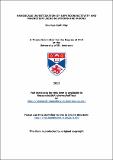Nanoscale investigation of superconductivity and magnetism using neutrons and muons
Abstract
The work presented in this thesis was broadly focussed on the investigation of the magnetic behaviour of different superconducting materials in the form of bulk (single crystals and pellets) and thin films (nanomagnetic devices like superconducting spin valves etc). Neutrons and
muons were extensively used to probe the structural and magnetic behaviour of these systems at the nanoscale along with bulk characterisation techniques like high-sensitive magnetic property measurements, scanning probe microscopy and magneto-transport measurements etc. The nanoscale interplay of Superconductivity and Ferromagnetism was studied in the thin film structures using a combination of Polarised Neutron Reflectivity (PNR) and Low Energy Muon Spin Rotation (LE-µSR) techniques while bulk Muon Spin Rotation (µSR)
technique was used for microscopic magnetic investigation in the bulk materials.
In the Fe/Pb heterostructure, evidence of the Proximity Effect was observed in the form of an enhancement of the superconducting penetration depth (λs) with an increase in the ferromagnetic layer thickness (dF) in both the bilayered and the trilayered structures. The existence of an Inverted Magnetic Region was also detected at the Ferromagnet-Superconductor (F/S) interface in the normal state possibly originating from the induced spin polarisation within the Pb layer in the presence of the neighbouring Fe layer(s). The spatial size (height
and width) of the Inverted Magnetic Region did not change much while cooling the sample below the superconducting transition temperature(Tc)and it also stayed unaffected by an increase in the Fe layer thickness and by a change of the applied magnetic field.
In the superconducting spin valve structure containing Permalloy (Py) as ferromagnetic layer and Nb as the superconducting layer, LE-µSR measurements revealed the evidence of the decay of magnetic flux density (as a function of thickness) within the Nb layer symmetrically from the Py/Nb interfaces towards the centre of the Nb layer in the normal state. The thickness dependent magnetisation decay occurred over two characteristic length scales in the normal state that stayed of similar values in the superconducting state also. In the
superconducting state, an additional contribution towards the magnetisation was found in the vicinity of the Py/Nb interfaces possibly originating from the spin polarisation of the singlet Cooper pairs in these areas.
The nanoscale magnetic investigation on a highly engineered F/S/F structure (where each of the F blocks made of multiple Co/Pd layers with magnetic moments aligned perpendicular to the plane of these layers and neighbouring magnetic blocks separated by Ru
layers giving rise to antiferromagnetic alignment) using LE-µSR showed an antisymmetric thickness dependent magnetic flux density profile with two characteristic length scales. In the superconducting state, the magnetic flux density profile got modified within the superconducting Nb₆₇Ti₃₃ layer near the F/S interfaces in a way similar to that of observed in the case of Py/Nb system, most likely because of the spin polarisation of the superconducting
electron pairs.
The vortex magnetic phase diagram of Bi₂Sr₂Ca₂Cu₃O10-δ was studied using the Muon Spin Rotation (µSR) technique to explore the effects of vortex lattice melting and rearrangements for vortex transitions and crossover as a function of magnetic field and temperatures. At low magnetic fields, the flux vortices undergo a first order melting transition from a vortex lattice to a vortex liquid state with increasing temperature while another transition also occurred with increasing field at fixed temperature to a vortex glass phase at the lowest temperatures. Evidence of a frozen liquid phase was found in the intermediate field region at low temperature in the form of a lagoon in the superconducting vortex state which is in
agreement with earlier observations made in BiSCCO-2212. The magnetic behaviour of the unconventional superconductor Sr₂RuO₄ was investigated using µSR to find the evidence of normal state magnetism and the nature of the vortex state. In the normal state, a weak hysteretic magnetic signal was detected over a wide temperature and field range believed to be supporting the evidence of a chiral order parameter. The nature of the vortex lattice structure was obtained in different parts of the magnetic phase diagram and the evidence of magnetic field driven transition in the lattice structure was detected from a Triangular→Square structure while the vortex lattice stayed Triangular over the entire temperature region below Tc at low fields with a disappearance of pinning at higher temperatures.
Type
Thesis, PhD Doctor of Philosophy
Collections
Items in the St Andrews Research Repository are protected by copyright, with all rights reserved, unless otherwise indicated.
Related items
Showing items related by title, author, creator and subject.
-
The dynamic topology of the solar corona : mapping the Sun’s three dimensional magnetic skeleton
Williams, Benjamin Matthew (University of St Andrews, 2018-06-26) - ThesisObservations of the surface of the Sun reveal multi-scaled, mixed magnetic features that carpet the entire solar surface. Not surprisingly, the global magnetic fields extrapolated from these observations are highly ... -
Analytical three-dimensional magnetohydrostatic equilibrium solutions for magnetic field extrapolation allowing a transition from non-force-free to force-free magnetic fields
Neukirch, Thomas; Wiegelmann, Thomas (2019) - Journal articleFor the extrapolation of magnetic fields into the solar corona from measurements taken in the photosphere (or chromosphere) force-free magnetic fields are typically used. This does not take into account that the lower ... -
Flux rope formation due to shearing and zipper reconnection
Threlfall, J.; Hood, A. W.; Priest, E. R. (2018-06) - Journal articleZipper reconnection has been proposed as a mechanism for creating most of the twist in the flux tubes that are present {prior to} eruptive flares and coronal mass ejections. We have conducted a first numerical experiment ...

